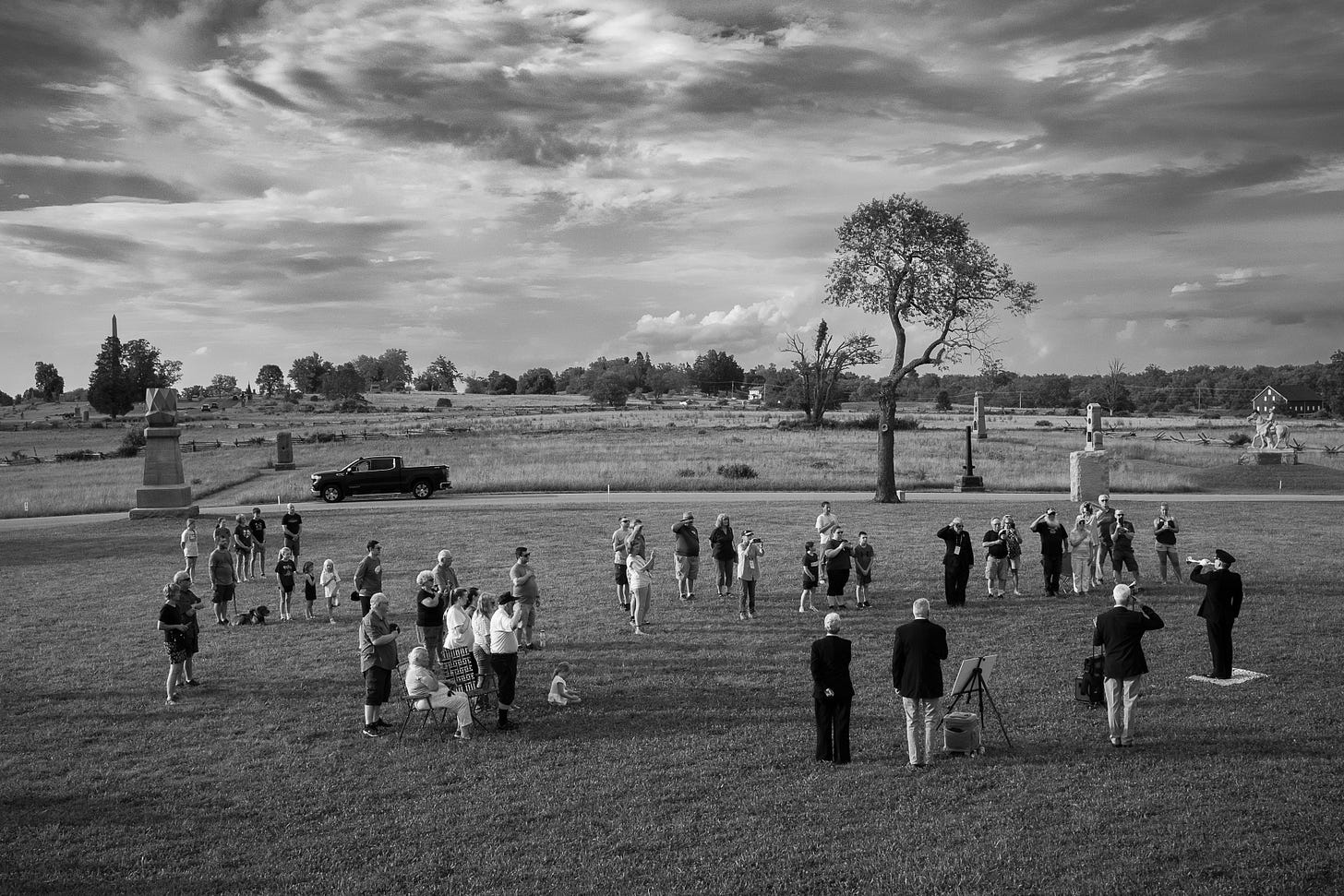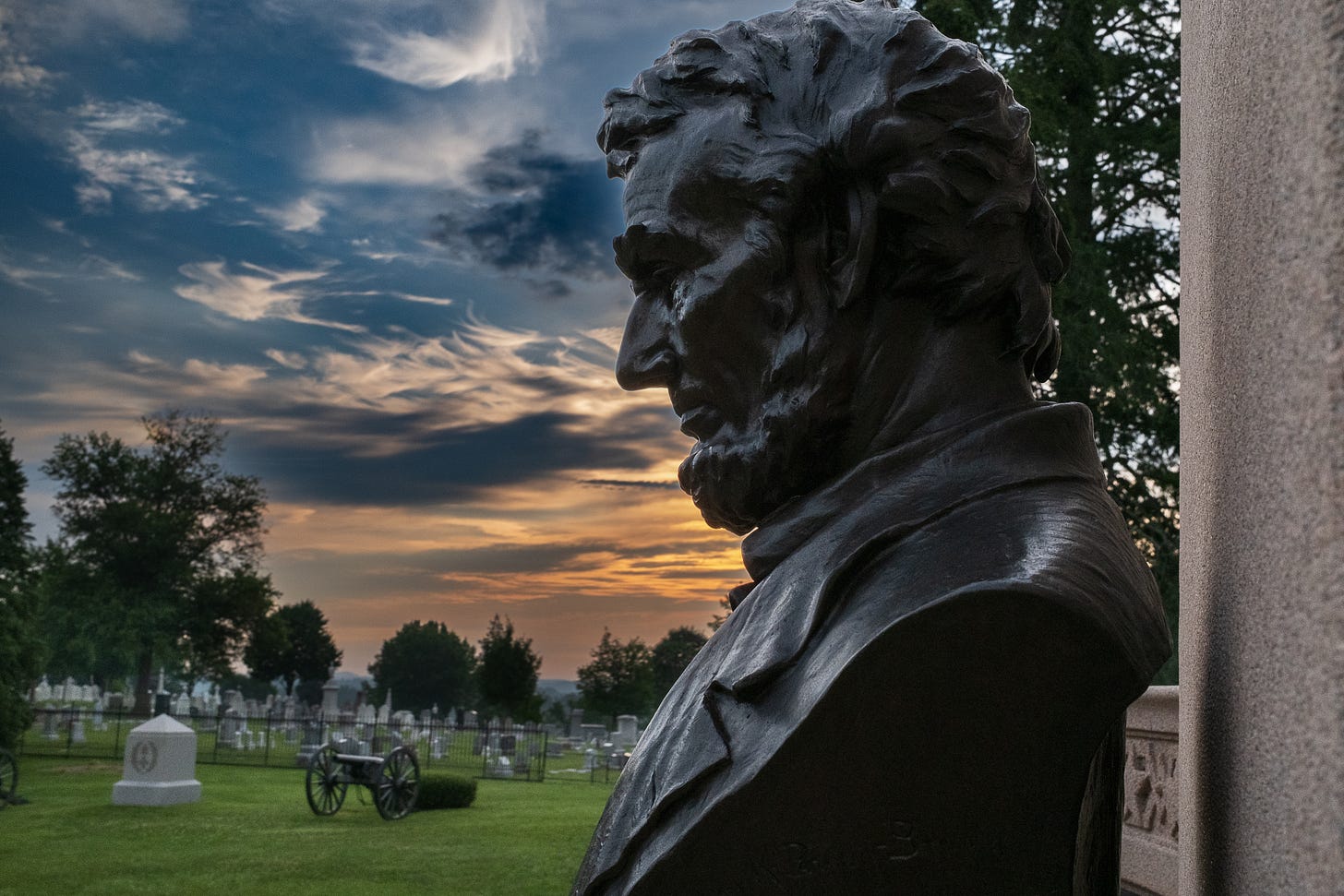Gettysburg and The Unhealed Wound
Understanding America's Current Division Through the Lens of Gettysburg
The gentle rolling hills around Gettysburg, Pennsylvania, give the bicyclist an ideal setting for early morning rides. The battlefield, void of a single automobile at dawn, is paved with black velvet. Yes, we cyclists have BTOS (black tar obsession syndrome.) I came for a week of teaching on my book, Everyday Spirituality, at our seminary. The lightly paced schedule allowed me time to take in much of the park, the battlefield, and the history of this high-water mark event in the American Civil War.
As we observe the rise of political polarization in America today, it’s worth asking: How did we get here? The answer, I suggest, lies not only in current politics but also in the unresolved psychological and spiritual wounds from our history. The Battle of Gettysburg, fought in July 1863, provides a powerful way to understand the archetypal patterns that continue to influence American consciousness and fuel our divisions.
This essay examines the enduring psychological and spiritual impact of the Civil War on today's political landscape. Besides, it’s the fourth of July weekend. What else are you going to do today?
The Shadow Unveiled: Gettysburg as Psychological Revelation
Carl Jung's concept of the Shadow—those aspects of ourselves and our communities that we deny, repress, or project onto others—provides insight into both the Civil War and our current moment. The Battle of Gettysburg represented more than a military engagement; it was a confrontation with America's collective Shadow.
The nation's fundamental contradiction—proclaiming liberty while enslaving millions—created what Jung would recognize as a psychological split. This split manifested not only in the literal division between North and South, but also in the deeper patterns that still influence American political discourse today.
Historical Context and Shadow Projection
Historian Charles Dew's research on Southern secession commissioners reveals the psychological mechanisms at work.[1] These officials, speaking candidly to persuade other states to join the Confederacy, articulated fears rooted in racial anxiety rather than constitutional principles. Their rhetoric demonstrates classic Shadow projection: externalizing moral contradictions by demonizing the "other" while maintaining an idealized self-image.
Crucially, this Shadow projection was not limited to the South. Northern indifference to genuine racial equality, combined with economic motivations for preserving the Union, reveals how both sides participated in the collective denial of America's foundational contradictions.
The Archetypal Battlefield: War as Soul-Making
James Hillman's analysis of war as a psychological and mythological phenomenon explains why Gettysburg continues to hold such significance in American consciousness. Hillman suggests that war fulfills archetypal roles—it offers meaning, transcendence, and the illusion of unity through shared sacrifice.
The 50,000 casualties at Gettysburg transformed the battlefield into what religious traditions might see as sacred ground. Lincoln's Gettysburg Address served a liturgical role, reframing death as a form of consecration and calling for "a new birth of freedom." This shift of trauma into meaning reflects what both psychology and spirituality recognize as a core healing process.
Yet Hillman also warns of war's alluring power—its "terrible beauty" that can make violence appear noble. This insight has strong implications for understanding modern political division. The psychological satisfaction of seeing political opponents as enemies, the sense of moral superiority gained by demonizing the "other side," and the community bonds formed through shared outrage all reflect the archetypal patterns Hillman describes.
Collective Trauma and Generational Transmission
From both psychological and pastoral perspectives, understanding trauma transmission is crucial. Jung's concept of cultural complexes or patterns explains how unresolved collective traumas create ongoing cycles that influence behavior across generations. The trauma of the Civil War—including not just battlefield deaths but also the systematic dehumanization of slavery—has left what might be called a "wound in the American soul."
The Mythology of Denial
The post-war emergence of the "Lost Cause" mythology, a set of beliefs romanticizing the confederacy and downplaying the role of slavery, represents a form of collective defense mechanism. Rather than integrating the horror and moral complexity of the conflict, American culture created competing narratives that allowed both sides to maintain idealized self-images while avoiding the painful work of genuine reconciliation.
This tendency to mythologize rather than confront difficult truths persists in today’s political discourse. We observe similar patterns in how various groups remember and interpret events, creating alternative narratives that serve psychological protection rather than fostering understanding.
Contemporary Manifestations: The Shadow in Modern Politics
The psychological patterns established during the Civil War era continue to influence American political culture in several key ways:
Binary Thinking and Moral Projection: The tendency to see political opponents not as fellow citizens with different views but as existential threats echoes the Shadow projection Jung described. This leads to what psychologists call "splitting"—the inability to accept complexity and ambiguity in relationships.
Trauma Reenactment: Unresolved collective trauma frequently appears through repetitive patterns. The cyclical nature of American racial tensions, the recurring themes of "us versus them" in political discourse, and the ongoing challenge of achieving true reconciliation all indicate continual trauma reenactment.
Sacred Victimhood: Both sides of today’s political divides often claim the role of sacred victims, reflecting the martyrdom themes Hillman pointed out in war psychology. This leads to what some call "competitive victimhood," where groups vie for moral superiority through their suffering.
Toward Healing: Integration and Individuation
Even mentioning the topic of healing carries a risk in this essay. I worry it might imply an easy solution, a quick fix, but anyone recovering from any form of addiction understands the true challenge. (And yes, I believe our US Civil War wound and subsequent denial is a form of addiction. Nonetheless, healing and hope remain central in my life, faith, and longing. Healing involves a process of becoming whole by integrating rejected parts of the self, whether they belong to an individual, a collective group, or even a nation. For both individuals and communities, healing involves what religious traditions call confession and what psychology refers to as acknowledgment: honestly confronting the Shadow instead of projecting it onto others.
Creating Spaces for Honest Reflection and Dialogue: I’ve long hoped that churches, mosques, and synagogues would embrace this role and offer environments where people can honestly examine their own participation in divisive patterns without fear of judgment. Outside of religious settings, organizations like Braver Angels are working to make this happen.
Modeling Integration: Leaders who can recognize complexity, hold multiple perspectives, and resist the urge to demonize opponents set a vital example for their communities. I know firsthand how challenging this can be, having held a public leadership position. The forces pushing you toward extreme, impulsive reactions are very strong. However, standing firm and explaining the nuances and complexity of issues might be the domino preventing others from falling. (Have I mixed my metaphors enough for you, phew?)
Facilitating Lament and Mourning: Both religious and psychological traditions acknowledge the significance of grief work in the healing process. America has never fully mourned the losses of the Civil War era, Vietnam, Iraq, and the long list of other tragedies—both battlefield deaths and ongoing casualties from racial injustice and emotional wounds.
Teaching discernment: Helping people distinguish between genuine political differences and simple projections is essential for fostering healthy democratic conversations. We might not use the word 'archetypal,' but everyone understands projection because we do it every day. Where are your biases? That’s a good starting point because it reveals your own hidden shadow, wounds, and conflicts.
The Ongoing Battle: Gettysburg as Mirror
Lincoln's call for "a new birth of freedom" at Gettysburg remains unfulfilled. The psychological and spiritual work of American well-being—becoming a nation that can hold its contradictions without splitting—continues. The battlefield at Gettysburg serves as both warning and promise: warning of what happens when Shadows are projected rather than integrated, and promise of what becomes possible when sacrifice is imbued with meaning and directed toward genuine transformation.
Conclusion: The Healing That Remains
The Battle of Gettysburg concluded in July 1863, but the ongoing psychological and spiritual struggle it symbolizes persists. Until America confronts its Shadow—the enduring legacy of racial injustice, economic inequality, and the persistent tendency to demonize rather than understand differences—the wound in the American soul will continue to fester.
Gettysburg serves as a reminder not only of past sacrifice but also of present opportunity. They call us to continue the work of national individuation—the slow, painful, but ultimately healing process of becoming whole. In this effort, religious leaders and mental health professionals serve as vital guides, helping individuals and communities navigate the challenging yet necessary journey from division to unity, from darkness to light.
The battle at Gettysburg may have ended, but the war for America's soul continues. The question isn't whether we'll face our Shadow, for the Shadow always makes itself known. The question is whether we can confront it consciously, courageously, and compassionately. This choice affects not just the future of American democracy but also the path toward true healing for a nation still trying to understand what it means to be whole.
More to Come,
James Hazelwood is an author and documentary photographer. His website is www.jameshazelwood.net

[1] Apostles of Disunion: Southern Secession Commissioners and the Causes of the Civil War. By Charles B. Dew. Charlottesville: University Press of Virginia, 2001. Pp. vii, 124, $22.95 (hbk), ISBN 0-8139-2036-1








Oh, thank you Jim!
Many years ago when I was at the church in Augusta Rebecca and I made a trip to her family in Northern Virginia. We took a day and visited the Holocaust Memorial in DC. I won't take the time here to try to describe the overwhelming impact that had on us.
Upon my return to Augusta I spoke of that impact in my sermon, including reflecting on how far we (humanity) are from God's intent & desire for us.
Afterward I had several conversations with members, of "good German/Lutheran background" who had been living in Germany during that time. These were some of the most faithful, compassionate, dedicated Christians I have known . . . , and their . . . attitude (mindset? perception? mental encapsulation?) . . . of that experience was and remains deeply troubling to me. Given their age I felt incapable of pushing them too hard on this. It struck me that this was, indeed, a deeply conflicted issue for them. The holocaust was such a complete violation of everything they held to be true yet they had, to some greater or lesser degree, allowed if not participated in that. As citizens of Germany at least. Should they have made themselves more aware of what was going on at the time and done more to stop or fight against it? Having NOT done that, would too much awareness of their failure to act then destroy them today? As their pastor in their later years what could/should I speak to them of grace without adding to the betrayal done to so many back then?
Yes, ongoing marinating . . . .
This is profound… I’m gonna have to reread it a few times to let it sink in… It feels really huge… but one bite at a time.